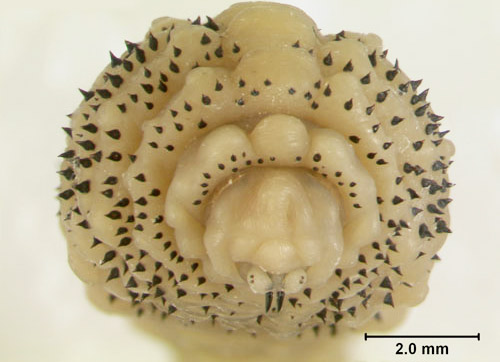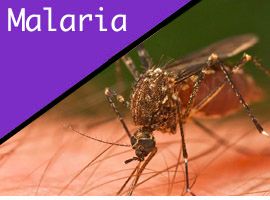What if I told you that there exists a fly – the botfly – that captures mosquitoes, ticks and certain other flies, holds them hostage long enough to attach their eggs to them and then sends them on their way. The mosquito, tick or fly then lands on your arm, bites you and inadvertently deposits the eggs.
The eggs hatch, and the larvae burrow into your skin, eventually reaching the subcutaneous layers. At this point, the larvae develop over the course of eight weeks before emerging from your skin. Think I’m joking? No, folks. Sadly, this thing is real.
Psyche!!! Don’t worry, the above photo is a fungal infection. It is improperly labeled as a botfly infestation on multiple websites. (photo source: reddit)
This is a botfly. It lives in the Americas, from southern Mexico down to northern Argentina, Chile and Uruguay. They are relatively rare – phew! – in these places, but they do tend to have more concentrated populations in warm, damp, humid areas.
How can you prevent a botfly infestation
There are a few things you can do to protect yourself from a botfly infestation:
- Wear clothing that keeps you covered – the more skin you have exposed, the more likely you are to have an egg land in the wrong place. Wear pants and long sleeves as much as possible, especially when mosquitoes are active, as they can carry the botfly’s eggs. You might want to wear a hat, too (see the video below).
- Use insect repellant – See our article on this topic for specific recommendations.
- Avoid dense brush and high grass – ticks can also carry botfly eggs. Avoiding ticks can help you avoid botfly larvae.
Why should you wear a hat? Here’s why:
That video has been viewed over 7 million times. Yikes.
What do you do if you have a botfly infestation?
Here’s the good news: botfly larvae do not carry disease, and there is a very low risk of serious complications or death. There is a risk of infection, but some basic antibiotics can take care of that.
Here’s the bad news: this thing (see picture) is growing inside of you, and eventually it has to burrow its way out. And there is no pill or cream that you can take that will dissolve it without leaving a trace. They need to come out the same way they came in (only, they will be about 10 times their original size for the exit trip).
You see those little spines? Yeah, those hurt. (photo credit)
If the botfly larvae have set up shop in the subcutaneous layers of your skin, you have a few options. You could go to the hospital and have the larvae surgically removed. Alternatively, you could put petroleum jelly over the welt, suffocate the larvae, and then remove the organism with tweezers (it will come to the surface).
Finally, you could just let the larvae do their thing. You know, grow inside of you for eight weeks and then burrow out of you on their own time. Either way, you should see a doctor so that they can prescribe you the appropriate antibiotics.
Botfly infections are rare. You would have to be an unlucky traveler (or a traveler that is spending a lot of time in the Amazon, like these people). Any experience with botflys among our readers? Please share all the gruesome details in the comments below. Want to read more on similarly terrifying organisms? We got you covered here.















{ 5 comments… add one }
The really interesting aspect of a botfly larva emerging from your skin is that it is painfree, and the resulting crater heals completely in 48 hours. It is unknown how this works.
The larvae bury themselves under the soil, undergo pupation, and some time later the botfly emerges, ready to take a new mozzie hostage – and the cycle begins again.
Aren’t parasites damn smart ?
Very interesting, about the pain-free exit Florian. Thanks for sharing.
I dug one out of a bunny in Fl. N.America. so they are farther north than people realize.
I live in Arkansas. I believe I am experiencing what all I’ve read about botflies. I have seen dark blue hairy flies. They are in the United States. I will vouch for that. the most excruciating pain I’ve ever felt. Hoping to get some help soon. Very scary.
Hello! About two weeks ago I was bitten by this fly in the backyard while cutting the grass and cleaning the pool. I’m an American who has been living in Brazil for over 20 years and this was my first contact the Botfly. Typically in Brazil these are only found in the rural areas and I live in a city in the mountains, but I did manage to get bitten and have to have 5 larvae extracted. Most of the pictures and videos you will see on the internet are from late stage larvae, but mine were still in the early stages and very painful. I’d guess they were at about the 10 day stage and they were all about the size of a large mosquito still. The problem with the smaller larvae at the early stages is that they burrow deep into your skin and are very hard to get at and remove. I did see a doctor who performed outpatient surgery and remove them. I won’t lie, it was extremely painful even after numerous shots to numb the pain. Sorry, but at one point I was screaming and cursing because the pain was so extreme. As far as the little larvae, they were seriously irritating my skin around the ankle and calf as well as one in my back. For the most part they were relatively quiet but then there would be these very intense short periods of lightning pain like hundreds of bee stings. It was awful. Through a lot of trial and error my wife and I finally discovered that the combination of oral anti-histamines (1 every 12 hours) and hidro-cortizone cream, I was able to keep the sharp, painful stings at bay for the most part. Rather than several times a day, they were down to maybe once a day at the most and no longer keeping me up at night. That was the worst part. Dead asleep and then having these things start moving around and cause extreme pain. I lost a lot of sleep until we figured out the combination of pills and cream to quiet the things down.
Now I’m left with some small wounds that are healing nicely and no more sharp, stinging pains from the larvae. Life is good again. I do not wish this parasite on anyone. I’ve thought about why these flies are around now when they haven’t been for the last 10 years we’ve been living in the mountains and the only thing I could attribute it to was the fact that we added another dog to our family who does her business in the yard. Our black lab does all of his business outside on the street during walks and my wife picks all of it up and bags it, but our new one uses the yard and I was leaving several piles at a time before cleaning it all up. Sure enough I went out there today to clean up some piles and without any doubt at all I know I saw this fly. It’s the only thing that makes sense at this point because until the new dog, there were no flies.
Anyway, best of luck to anyone having to deal with this menace. Seek professional medical help because if you try digging them out yourself you can cause a serious infection or worse. Let a professional doctor handle it. Good luck!
Johnny D.